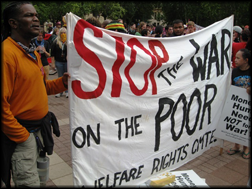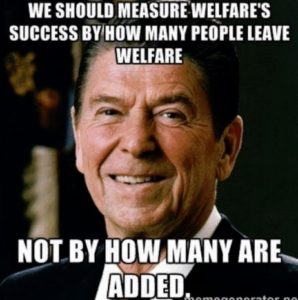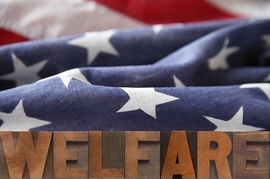We have been inundated for decades about single-family homes, absent father, welfare, and about all those who fall into these categories. And, quite honestly, most of those conversations include characterizations about welfare recipients that are not very flattering. Stories about minority Americans filling a grocery basket with ribeye steaks, wine, beer, and high dollar snacks then paying for them with food stamps and driving away in a luxury car. I’m not certain about the truth of such stories but I AM certain about negative characterizations of single moms and others who receive government assistance.
Make no mistake: there are those who take advantage of the welfare system. Abuse occurs in every government program in which someone receives benefits there certainly is abuse here. But the fundamental premise of this system is to provide to those who find themselves in dire situations in which suffering without help is real assistance to provide for needs while that person or persons get through their crisis. That’s what Americans do: help each other.
What is also true is that single-parent homes in the U.S. are rapidly climbing in numbers. And with that comes much talk, finger-pointing, and blame.
Before we launch into our investigation of this system, let me make one statement: there are far more Caucasian people that are recipients of welfare and other government assistance than there are African-Americans. Needing and receiving government assistance is NOT color specific: it impacts all races, ethnicities, religions, and those from multiple places of origin. What IS common among them is “need.” That need is why welfare was established and why it has been updated and even expanded over the last decades. Does it need changes? Is there abuse? These are things that need to examined and constantly monitored.
Let’s look at the big picture of this process, get some facts, and objectively begin to understand what those who find themselves receiving government assistance are going through. There’s not wrong with facts to be able to make reasoning decisions!
Truths of the Story
CNN’s Don Lemon says more than 72% of African-American births are out of wedlock. Here’s a look at the numbers Lemon’s uses to support that statement:
Race/Ethnic Group Percentage Single-parent
Non-Hispanic Whites 25%
Hispanics 42%
American Indian/Alaskans 53%
African-Americans 67%
There has been no significant increase in the number of married-couple families with children in the U.S. since 1965. By contrast, the number of single-parent families with children has skyrocketed by nearly 10 million, rising from 3.3 million in 1965 to 13.2 million in 2012. Since single-parent families are roughly four times more likely to lack self-sufficiency (and be officially poor), this unraveling of family structure has exerted a powerful downward pull against self-sufficiency and substantially boosted the official child poverty rate. When the War on Poverty began, 36 percent of poor families with children were headed by single parents. Today, the figure is 68 percent.
Since the inception of the War on Poverty in 1964, the welfare state has promoted single parenthood in two ways. First, means-tested welfare programs financially enable single parenthood. It is difficult for single mothers with a high school degree or less to support children without the aid of another parent. Means-tested welfare programs substantially reduce this difficulty by providing extensive support to single parents. Welfare thereby reduces the financial need for marriage. Since the beginning of the War on Poverty, less-educated mothers have increasingly become married to the welfare state and to the U.S. taxpayer rather than to the fathers of their children. As means-tested benefits expanded, welfare began to serve as a substitute for a husband in the home, and low-income marriage began to disappear. As husbands left the home, the need for more welfare to support single mothers increased. The War on Poverty created a destructive feedback loop: Welfare promoted the decline of marriage, which generated a need for more welfare.
A second major problem is that the means-tested welfare system actively penalizes low-income parents who do marry. All means-tested welfare programs are designed so that a family’s benefits are reduced as earnings rise. In practice, this means that, if a low-income single mother marries an employed father, her welfare benefits will generally be substantially reduced. The mother can maximize welfare by remaining unmarried and keeping the father’s income “off the books.” For example, a single mother with two children who earns $15,000 per year would generally receive around $5,200 per year of food stamp benefits. However, if she marries a father with the same earnings level, her food stamps would be cut to zero. A single mother receiving benefits from Section 8 or public housing would receive a subsidy worth on average around $11,000 per year if she was not employed, but if she marries a man earning $20,000 per year, these benefits would be cut nearly in half. Both food stamps and housing programs provide very real financial incentives for couples to remain unmarried.
There are so many stories about the Welfare System: who benefits from its use, the dangers, the abuses, and the dollars involved. We thought it best to go back and look at its history in the modern world. Bill Clinton took the bull by the horns in his second term and Congress on his watch made the last significant changes in the system. Let’s take a look back so we can (with an educated and factual perspective) know exactly where the U.S. Welfare System is today in the U.S.
Welfare in 21st Century America
April McCray thought she had finally caught a break in late 2005. That’s when the state of Louisiana granted cash assistance to the single mother through the Temporary Assistance of Needy Families (TANF) program. (Temporary Assistance to Needy Families) It was her first experience with America’s welfare program.
McCray, who had been in and out of work, struggled to make ends meet. This, she hoped, would at least help soften the burden.
But a month later, the state stripped her of the benefits without a clear explanation, she said. Since then, she says Louisiana, which controls state and federally allocated TANF dollars, has denied her requests for assistance several times.
 “It gets depressing,” said McCray, who in 2019, was still struggling. With three kids and rarely more than a part-time job, she says she needs help she can’t seem to get from a welfare system that was overhauled 20 years ago.
“It gets depressing,” said McCray, who in 2019, was still struggling. With three kids and rarely more than a part-time job, she says she needs help she can’t seem to get from a welfare system that was overhauled 20 years ago.
Overhauling welfare was a hallmark of then-President Bill Clinton’s time in office. When he signed welfare reform into law on Aug. 22, 1996, he declared at a ceremony in the White House’s Rose Garden that it would “end welfare as we know it.”
Twenty years later, few would dispute the accuracy of that prediction. Welfare is, and has been, a vastly different system than it was prior to the law, which gave states wide control over their own welfare programs by allocating to them block grants.
So, two decades-plus later, are those changes working? It depends whom you ask.
TANF’s legacy has divided policy experts, with supporters saying it put an emphasis on work and increased employment among single mothers in the process while also reducing poverty overall. The program’s critics say it tore a hole in the safety net for people who remained in poverty and couldn’t find steady work, like McCray.
“(TANF) did shift the emphasis toward work. I think that is something where there has been a lot of agreement,” said Heather Hahn, a senior fellow at the Urban Institute. “… As far as whether people are better off, I do think they are, in some cases, worse off.”
What America’s welfare system used to be
Welfare didn’t exist in America before the Great Depression and Franklin D. Roosevelt’s New Deal. It officially came into being as a rule under the Social Security Act in 1935, offering aid to families with dependent children (AFDC).
In establishing the program, the federal government, for the first time, took responsibility for helping children with a parent who was dead, gone or otherwise incapacitated. Previously, those children most likely would have been institutionalized.
Over several decades, AFDC went through several changes and revisions, perhaps most notably in 1961 when it expanded its definition of a “deprived child” to include one who had an unemployed parent. And, though the benefits were small, many families did end up dependent — and the criticism poured in.
The program was blamed for encouraging unwed mothers, and for discouraging work. It included phaseout rates, meaning that dollars earned meant less dollars in assistance.
Presidents Lyndon Johnson and Ronald Reagan chipped away at changes, instituting job training and work requirements for AFDC participants. But by the 1990s, calls were clearly pouring in for change.
Enter Bill Clinton, who championed the most radical overhaul of America’s welfare system to date. Clinton, amid a re-election campaign, made reforming the program part of his bid to win back the White House.
When TANF became a law, a lot changed
The newly minted Temporary Assistance for Needy Families (TANF) put an emphasis on getting people out of poverty and to work.
Under TANF, recipients in most cases are required to participate in work activities for 30 hours a week. Combined with expansions to the Earned Income Tax Credit, a tax credit for people with low- to-moderate-income jobs, TANF succeeded in getting people to work, especially during Clinton’s presidency.
From 1996 to 2000, employment rates among never-married mothers shot from 63% to 76%, according to the non-partisan Center on Budget and Policy Priorities (CBPP). Additionally, both poverty rates among families with single mothers and overall poverty rates dropped.
“The welfare reform legislation moved us in the right direction by being much more aggressive about employment for the single mother population,” said Robert Doar, a scholar at the American Enterprise Institute who was formerly the commissioner of welfare in New York City.
Employment and poverty rates have leveled off in the long term, which has resulted in disagreement among policy experts about just how effective TANF has been in increasing employment, though most agree that it at least helped move the needle.
Where the law has failed, experts say, is by leaving behind those at the very bottom — the group of people in deep poverty who typically haven’t been able to find work, like McCray.
Studies have found that since TANF was instituted, deep or extreme poverty has increased. A 2011 study by the University of Michigan’s National Poverty Center found that families living on less than $2 per person a day more than doubled from 1996 to 2011.
Block grants: The good and the bad
 Hahn of the Urban Institute and Liz Schott of the CBPP each attribute the rise in deep poverty largely to TANF. They pointed to three main flaws with the legislation: the block grants don’t adjust for inflation; states have often spent large portions of their TANF dollars on things other than basic assistance; and states sometimes have incentives to cut needy recipients loose from the program.
Hahn of the Urban Institute and Liz Schott of the CBPP each attribute the rise in deep poverty largely to TANF. They pointed to three main flaws with the legislation: the block grants don’t adjust for inflation; states have often spent large portions of their TANF dollars on things other than basic assistance; and states sometimes have incentives to cut needy recipients loose from the program.
Since TANF became law, states have received fixed block grants from the federal government. When lawmakers were constructing TANF, Democrats in Congress wanted to include an inflation adjustment for the grants, said Ron Haskins, a Brookings Institution senior fellow who helped draft welfare reform as a staff member on the House Committee on Ways and Means.
An inflation adjustment would have enabled the amount of the block grants to increase along with inflation. But the law passed through a Republican-held Congress without one.
“Remember, in 1996 we were in midst of a huge budget fight, and Republicans were trying to balance the budget and savings were a huge deal,” said Haskins, who considers the reform mostly a success.
Not adjusting for inflation has caused the block grants to erode by about a third since 1996, according to the CBPP. That has essentially reduced the benefits states can give out, as well as the number of families that receive benefits, even as the number of needy families hasn’t been going down.
In addition, states have great flexibility in how they can spend their block grants. The money spent must fit into one of TANF’s four main purposes: assisting needy families; promoting work and marriage; reducing out-of-wedlock pregnancy; and increasing two-parent families.
States have wide discretion in determining what falls under those broad purposes, and that has led to significant spending on things other than core welfare services.
That’s a problem, Hahn said, because providing families with cash or helping parents find jobs are the two most effective ways to lift families out of poverty, since both provide them with incomes. In the most recent data available, 26% of national TANF spending went toward cash welfare, while only 8% went to work programs, according to the CBPP.
“It doesn’t always have to be about cash, but it should be about getting people to work,” Schott said.
Summary
Donald Trump didn’t often discuss welfare reform or TANF during his presidential campaign or so far in his presidency. But in his 2011 book, Time to Get Tough, Trump praised welfare reform for emphasizing work and said other welfare programs should follow the same approach.
While discussing welfare in an interview with Fox’s Sean Hannity, though, Trump said people need even more of an incentive to work — which he would seek to create.
“Right now, they have a disincentive,” he said in the interview. “They have an incentive not to work.”
The Trump Administration has paid an enormous amount of time in examination of the U.S. social safety environment. They have made remarkable changes in areas in which Americans have suffered and seemingly been ignored. It is likely that between today and the day of the 2020 election we will see dramatic and positive moves made by this Administration to improve America’s welfare system.
One thing we know for certain: Mr. Trump cares tremendously for Americans. That’s NOT just true about today. His life before politics was full of stories in which he helped numerous Americans who faced problems of many kinds that were no fault of their own. I imagine he’s still the same man and feels the same about his fellow Americans.

